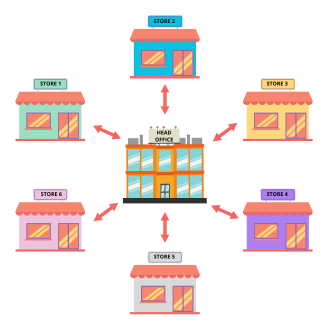The Unified Codebase Solution For Managing Multiple Shopify Plus Expansion Stores
Swanky has developed an innovative solution to transform how large-scale retailers approach international ecommerce on Shopify Plus. Find out about the unique multi-store unified codebase solution we have developed, the commercial benefits it unlocks, and how we’ve implemented this for several of our international clients.
Written By
Jamie McCleave

Typically, larger retailers selling internationally on the Shopify Plus platform will implement a multi-store, or expansion store, model. An expansion store is an additional storefront, fully localised to serve a specific region. This approach gives retailers greater control and flexibility in their approach to the individual markets they sell in.
Whilst the use of expansion stores offers extensive flexibility and localisation, a key challenge for retailers can be the increased time and costs spent maintaining and developing additional storefronts. In particular, duplication of development work across a portfolio of expansion stores can be inefficient, expensive, and create unwanted divergence in code quality. Where local ecommerce teams are customising content and campaigns, there is a risk that localisation efforts create unacceptable levels of divergence from the ‘core’ store architecture and functionality.
For cross-border retailers, the introduction of Shopify Markets in 2021 improved the options available, by enabling a single Shopify store to be localised depending upon the location of the end-customer. For many clients, Markets is an excellent way to launch and gain traction in new geographies.
However, Markets remains somewhat limited in its capabilities and may not be an appropriate solution where higher levels of localisation are required, or where local ecommerce teams wish to have greater control over the ecommerce store in their region. You can read more about these two approaches to internationalisation and the reasons you might choose one over the other in our comprehensive comparison piece on Shopify Markets vs expansion stores.
A new way to manage multiple Shopify Plus expansion stores
To combine the advantages of both Markets and expansion stores, Swanky has developed a new approach to maintaining multiple expansion storefronts on Shopify Plus with a single codebase.
Our solution allows for localised content and functionality, including giving local ecommerce teams the ability to deploy region-specific content and campaigns, whilst protecting the integrity of the core store codebase. This mitigates the complexity of multi-store management and greatly reduces development and maintenance overheads.
This article will explore how our multi-store codebase works, and the benefits it provides to international retailers. We’ll also look at how the solution is being used by our clients Wilkinson Sword and One Retail Group.
How this international multi-store solution works
At the core of our approach is the creation of a ‘master store’ where the core codebase is centrally held. Any fundamental changes can be deployed once, and extrapolated to each relevant expansion store in localised markets. Server-side scripts automate this deployment across multiple stores.

A unique branching strategy means each store can retain unique elements within the shared codebase, whilst advanced version control mechanisms allow individual changes to be tracked and managed. This allows us to retain the local specificity of each regional store while leveraging the shared components from the central codebase.
Our solution also integrates seamlessly with third party apps in the broader Shopify ecosystem, minimising friction during the implementation process.
Commercial benefits for international retailers
Our unique approach to multi-store management on Shopify Plus unlocks various commercial benefits for retailers.
1. This solution enables brands to roll out expansion stores quickly and easily once the master store has been created. In fact, we have found that an expansion store can in some instances be created in as little as two weeks, enabling businesses to rapidly scale across regions.
2. This is particularly pertinent for multi-brand groups or those looking to incrementally internationalise. In some instances, clients have been able to opportunistically create an expansion store in a new market, knowing that our approach has radically reduced the cost and complexity of doing so.
3. Having a unified codebase for multiple stores also provides significant time and cost savings. For example, where it may have traditionally taken one day per store for a Shopify developer to implement a new banner, our solution means that a banner can be deployed in the master store and then automatically implemented on expansion stores – meaning one day’s work for all stores, whether three or 30. The time and budget saved can then be funnelled into other meaningful revenue-driving growth activity.
4. In addition, this custom solution resolves typical issues around global ecommerce team store management. Local ecommerce teams inevitably want to be able to implement local strategies and campaigns. Indeed, effective internationalisation requires a high level of localisation. However, with a more traditional multi-store approach this can result in greater divergence than is desirable, with each local team effectively creating a unique Shopify store, making it hard to govern centrally. Our solution resolves this issue, empowering local teams but maintaining brand and codebase integrity in the master store.
5. Finally, it’s worth noting that as well as simplifying the management of multiple expansion stores, our multi-store codebase represents a perfect solution for brand groups with separate stores for each of their brands. It enables rapid deployment of individual brand stores, without the overheads traditionally associated with building a store from scratch.
Case studies
We are now regularly leveraging our multi-store codebase solution for international clients. Here are two examples of the solution in action.
Wilkinson Sword: Efficient flexibility in individual markets
Global personal grooming brand Wilkinson Sword benefited from one of the first implementations of our solution in 2022.
Seeking greater control and flexibility in their approach to each individual international region, the brand opted for a multi-store setup on Shopify Plus. This would allow them to serve different products, price points and promotions across the UK, French and German markets.
To negate the increased complexity and costs associated with this expansion store model, we implemented our innovative multi-store codebase solution. This streamlined the deployment of website changes and additions, thereby creating sizable efficiency gains.
Read our case study to learn more about the work we’ve done for Wilkinson Sword as a full-service ecommerce agency.
One Retail Group: Multi-brand group migrating to Shopify Plus
More recently, we leveraged this solution to support One Retail Group’s multi-brand migration from WooCommerce to Shopify Plus.
In this case, we were able to expedite the launch of the group’s multiple international brands on Shopify Plus, rolling out expansion stores for each brand in a significantly reduced timeframe.
Revolutionising international selling on Shopify Plus
Our centralised codebase management system represents a significant departure from having to maintain separate expansion stores for each market. This is a highly customisable, yet cost-efficient, solution for managing international storefronts, combining the scalability of Shopify Markets with the localisation benefits of expansion stores.
If you’d like to continue the conversation with us, please reach out to our team and we’d be happy to discuss our unique approach to multi-store management and how it can benefit your business.
We’d also recommend exploring our industry-leading guide to internationalisation on Shopify Plus. This comprehensive resource combines the expertise of Swanky’s ecommerce specialists with several of our technology partners, covering topics such as platform, international marketing, operations, and fulfilment.

